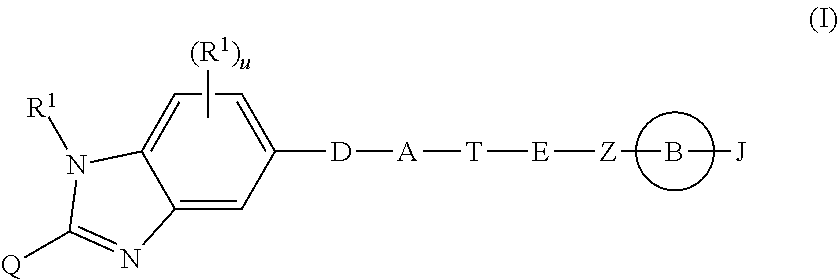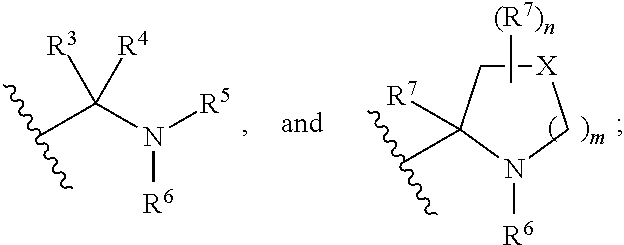Novel benzimidazole derivatives
a technology of benzimidazole and derivatives, which is applied in the field of new antiviral agents, can solve the problems of hcv genotype, less effective therapy against infections, and unlikely development of a successful vaccine in the near future, and achieve the effect of treating or prophylaxis of viral infections
- Summary
- Abstract
- Description
- Claims
- Application Information
AI Technical Summary
Benefits of technology
Problems solved by technology
Method used
Image
Examples
example 1
[0184]
[0185]Step 1a. A mixture of N-Boc-L-proline (5.754 g, 26.7 mmol) and TEA (3.73 mL, 26.7 mmol) in THF (60 mL) at −20° C. was treated with ethyl chloroformate (2.55 mL, 26.7 mmol) for 30 minutes before a slow addition of 4-bromo-1,2-diaminobenzene (5.00 g, 26.7 mmol) in THF (20 mL). It was then kept at −20° C. for 1 hour and then slowly warmed up to rt and stirred at rt overnight. The volatiles were evaporated and the residue was partitioned (EtOAc-water). The organics were washed with brine, dried (Na2SO4), filtered and evaporated to give the crude desired compound as a dark brown foam (10.7 g). ESIMS m / z=384.18, 386.18 [M+H]+.
[0186]Step 1b. A solution of the crude compound from step 1a (10.7 g, 26.7 mmol at most) in glacial acetic acid (100 mL) was heated at 50° C. for 2 hours. The volatiles were evaporated off and the residue was partitioned (EtOAc-aqueous NaHCO3). The organics were washed with brine, dried (Na2SO4), filtered and evaporated. The residue was purified by chroma...
example 2
[0191]
[0192]Step 2a. A solution of the compound of example 1 (20.0 mg, 33.4 μmmol) in 1,4-dioxane (1 mL) was treated with HCl in 1,4-dioxane (4 M, 4 mL) at rt for 30 minutes. The volatiles were evaporated off to give the crude desired compound as a yellow solid which was directly used in the next step. ESIMS m / z=399.35 [M+H]+.
[0193]Step 2b. A mixture of the crude compound from step 2a (33.4 μmmol at most) and (R)-(methoxycarbonyl)amino phenyl acetic acid (prepared according to WO 2008 / 021927, 20.9 mg, 0.100 mmol) in DMF (3 mL) was treated with HATU (31.7 mg, 83.5 μmmol) in the presence of DIPEA (83.0 μL, 0.668 mmol) for 2 hours at rt and the volatiles were evaporated off to provide a brown syrup. It was purified by chromatography (silica, CH2Cl2-MeOH) to give the title compound as a yellow solid (23.8 mg, 2 steps 91%). ESIMS m / z=781.67 [M+H]+.
example 1-1
[0194]
[0195]Step 1-1a. A mixture of the compound from step 1d (0.559 g, 1.425 mmol), trimethylsilyl-acetylene (0.60 ml, 4.275 mmol), CuI (28.5 mg, 0.150 mmol) and Pd(PPh3)2Cl2 (80.0 mg, 0.114 mmol) in Et3N (15 mL) was heated at 80° C. under N2 for 6 hours before being evaporated. The residue was purified by chromatography (silica, hexanes-ethyl acetate with 1% Et3N in ethyl acetate) to give the desired compound as a yellow foam (0.484 g, 83%). ESIMS m / z=410.24 [M+H]+.
[0196]Step 1-1b. A suspension of the compound from step 1-1a (0.484 g, 1.182 mmol) and K2CO3 (0.408 g, 2.954 mmol) in methanol (12 ml) was stirred at rt for 3 hour. The volatiles were evaporated off. The residue was purified by chromatography (silica, dichloromethane-ethyl acetate) to give the desired compound as a yellow foam (0.370 g, 93%). ESIMS m / z=338.24 [M+H]+.
[0197]Step 1-1c. A mixture of the compound from step 1-1b (80.0 mg, 0.2371 mmol), the compound from step 1b (86.8 mg, 0.2371 mmol), CuI (2.2 mg, 0.01185 mmo...
PUM
| Property | Measurement | Unit |
|---|---|---|
| Fraction | aaaaa | aaaaa |
| Fraction | aaaaa | aaaaa |
| Fraction | aaaaa | aaaaa |
Abstract
Description
Claims
Application Information
 Login to View More
Login to View More - R&D
- Intellectual Property
- Life Sciences
- Materials
- Tech Scout
- Unparalleled Data Quality
- Higher Quality Content
- 60% Fewer Hallucinations
Browse by: Latest US Patents, China's latest patents, Technical Efficacy Thesaurus, Application Domain, Technology Topic, Popular Technical Reports.
© 2025 PatSnap. All rights reserved.Legal|Privacy policy|Modern Slavery Act Transparency Statement|Sitemap|About US| Contact US: help@patsnap.com



